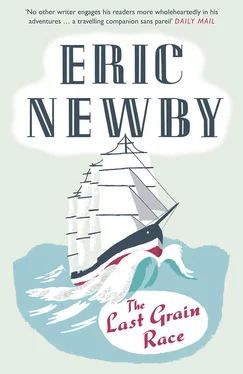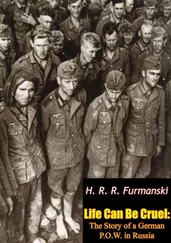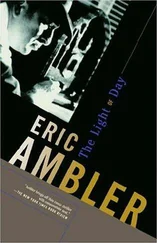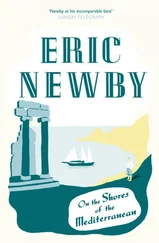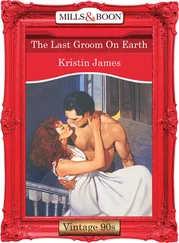Between the two washrooms stood the anchor windlass with its massive cables, and the salt-water pump, a very rickety affair with a pipeline aft to the main deck.
Immediately aft of the pump was No 1 hatch, a tiny thing eight feet square, leading down into the tween deck space and also to the forepeak where the bulk of the coal for the galley was kept. Forward of the coal store were the chain lockers, two vertical shafts in which the anchor cables were faked down link by link as they came in over the windlass pawls above. In the forepeak were great coils of wire strop, mooring springs and towing hawser, and for some distance aft in the ’tween-deck the space was filled with a pell-mell of bundled sail. The ’tween-deck was really an upper hold eight feet high, extending the length and breadth of the ship as far as the after peak, or lazarette, beneath the poop. This deck was pierced through by tonnage openings of the same size as the hatches above them. At sea both the hatches above and the tonnage openings below were battened down, cutting off the upper and lower holds. There was no artificial light below and because of this there was to be a nasty accident quite soon.
Next to No 1 hatch the great trunk of the foremast rose up through the deck from its roots on the keelson of the ship. By the mast was a teak fife rail with iron belaying pins to which the headsail halliards and the sheets of four square sails above the lower topsail were belayed; the lower topsail and foresail sheets were belayed to cleats on the fore part of the mast itself. Not far distant from the fore mast were the halliard winches for raising the upper topsail yards and topgallant yards when setting sail. The royal halliards rove through blocks and were belayed to the pin rails. It took ten men to raise a royal yard. The square sail halliards were so placed that with the yards raised they became in effect additional backstays.
Abaft the foremast was the donkey boiler room with a hinged funnel on top where Jansson and his even more savage-looking superior tended their charge, which was intended to raise the anchors. On very rare occasions it provided power for sending aloft the heavier sails. Here the Donkeymen kept the tools of their trade, which included a blacksmith’s forge, spares for the winches and, an important item, a blow-lamp with which they were always brewing cocoa, happily independent of the irascible cook. On either side of the donkey house was a capstan to which the sheets of the great foresail were brought through fairleads in the bulwarks. They were also used to send sail aloft by manpower.
Between the donkey house and the raised bridge deck amidships was No 2 hatch with Jansson’s dismantled winch beside it. Here the Belfast stevedores, using shore cranes, were unloading with an almost ritualistic deliberation, like figures in a slow-motion film of a coronation ceremony. To port and starboard were the pin rails for the forebraces which controlled the final angle or trim of the foresail and upper and lower topsail yards after they had been roughly braced round with a Jarvis brace winch. Only the course and topsail yards on each mast were operated by winches. The hand braces for the topgallant and royal yards came down to the deck still farther aft on the midships section, and were belayed to the fife rail at the mainmast.
Next to the mainmast was the Jarvis brace winch for the foremast yards with which four men could brace round the course and upper and lower topsail yards according to the direction of the wind, the wire braces playing out on cone-shaped drums on one side of the winch, whilst the slack was taken up by a similar set on the other side. There were three Jarvis brace winches in Moshulu , which eased what would otherwise have been an almost impossible task in so large a vessel for a crew as small as ours. The remaining yards, the two topgallants and the royals, were braced round with long rope braces. In the same way those operated by the winch had also to be trimmed properly by hand.
The forepart of the raised bridge-deck was painted white and had brass scuttles set in it. These portholes shed some light into the port and starboard fo’c’sles and into the galley where the Cook, that most wretched of men, lived in a stifling atmosphere filled with escaping steam, looking very much like ‘the Spirit of the Industrial Revolution’ in a Nursery History of England. The bridge deck, sixty-five feet long, forty-seven feet on the beam, was connected with the fo’c’sle head and poop decks by flying bridges over the fore and main decks which enabled the Mates to move about more quickly when issuing orders. On the bridge-deck was the charthouse, a massive construction where the charts, sailing directions, log-book, barometer and navigational instruments were housed. A companion-way led below to the Officers’ quarters.
Right amidships were the two massive teak wheels connected with the steering-gear aft by well-greased wire cables running through sheaves in the deck. These cables would sometimes break when a heavy sea was running. In a big gale three men would stand on the raised platforms to assist the helmsman who checked the more violent movements of the wheel with a foot-brake set in the floor. In front of the wheel was the big brass binnacle and behind the helmsman was the ship’s bell on which he echoed the striking of the clock inside the charthouse. On a brass plaque below the bell was engraved: Wm. Hamilton, Shipbuilders, Port Glasgow .
Beneath the bridge-deck, in the forepart, were the port and starboard fo’c’sles with the galley in between them; the Petty Officers’ cabin, which housed Carpenter, Donkeymen, and the Sailmaker’s assistant, who normally worked by day; and the Sailmaker’s loft. In the after part were the six rooms of the Master’s accommodation – saloon, bathroom, cabin, etc – spare room for guests – and the Officers’ quarters, also the accommodation for the Steward and Cook. The Steward, Steward’s boy and Cook lived aft but helped to work the ship, and even went aloft when the necessity arose.
Short ladders to port and starboard led down to the 130-foot long main deck, where the ports of the Captain’s saloon amidships faced on to No 3 hatch. By the mizzen mast was another Jarvis winch for the mainbraces, the mizzen halliard winches and the main pumps. On either side of it were skids supporting the ship’s motor-boat and a gig. Farther aft, to port and starboard, were two sets of davits each supporting a lifeboat. Between them was the standard compass on a raised platform, level with the flying bridge and connected with it, a henhouse on skids above the deck, No 4 hatch, a freshwater tank, just before the break of the short poop and the jigger mast with the mizzen brace winch. On the poop was the patent sounding machine, a capstan and the spare kedge-anchor.
Beneath the poop was the entrance to the after peak where the stores were kept. It was covered with a grating, heavily padlocked. Also under the poop was a pair of auxiliary wheels which could be connected to the steering-gear if the cables parted; there was also a binnacle with a compass card that displayed the most extraordinary abberrations. The helmsman’s head projected right through the deck, but he was so walled-in by a curved steel coaming above and on either side that only a very imperfect view aloft could be had through the glass window in the front of it. There were six compartments under the poop. Two were originally intended for the apprentices, one was appropriated by the Sailmaker as a cabin in cold weather, another served the Carpenter as a workshop.
The bulwarks on the fore-well and main decks were shoulderhigh and fitted with steel doors at intervals, hinging outwards from the top. These freeing ports enabled the water to drain off when the ship took a heavy sea. They made an abominable din and ropes were often washed off belaying pins and jammed in them.
Читать дальше
